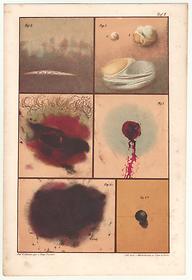Bloodstain, blisters, bullet holes, 1864
Medical professor Johann Ludwig Casper was perhaps the first author to use richly colored lithographs to illustrate forensic pathology. The plates show specific postmortem examinations, some of them experiments on cadavers.
Johann Ludwig Casper, M.D., Atlas zum Handbuch der gerichtlichen Medicin [Atlas for the Manual of Legal Medicine], Berlin; Artist: Hugo Troschel; Lithographer: Winckelmann & Sons
National Library of Medicine
